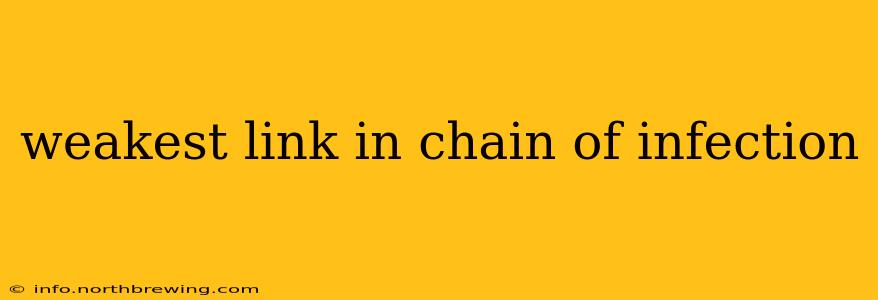The chain of infection is a model used to understand how infectious diseases spread. It highlights several key links that must be present for an infection to occur. Identifying the weakest link in this chain is crucial for preventing and controlling outbreaks. While the weakest link can vary depending on the specific infectious agent and the context, focusing on breaking any link significantly reduces the risk of transmission. Let's explore the chain and potential vulnerabilities.
What are the Links in the Chain of Infection?
The chain of infection typically consists of six links:
- Infectious Agent: The pathogen (bacteria, virus, fungus, parasite) causing the disease.
- Reservoir: The place where the pathogen lives and multiplies (e.g., humans, animals, environment).
- Portal of Exit: How the pathogen leaves the reservoir (e.g., respiratory droplets, feces, blood).
- Mode of Transmission: How the pathogen travels from the reservoir to the host (e.g., direct contact, airborne, vector-borne).
- Portal of Entry: How the pathogen enters the new host (e.g., mucous membranes, broken skin).
- Susceptible Host: An individual who is vulnerable to the infection due to weakened immunity or lack of prior exposure.
Which Link is the Weakest? It Depends!
There's no single universally "weakest" link. The effectiveness of targeting a specific link depends heavily on the infectious agent and circumstances. For instance:
-
For highly contagious airborne diseases (e.g., measles, influenza): Targeting mode of transmission (through measures like mask-wearing, improved ventilation, and social distancing) might be the most impactful. The virus's ability to spread efficiently through the air makes it challenging to control at the reservoir or portal of exit.
-
For diseases spread through contaminated food or water (e.g., cholera, typhoid): Interrupting the reservoir (e.g., through proper sanitation and water treatment) and the mode of transmission (e.g., through handwashing and safe food preparation) are critical.
-
For diseases transmitted through vectors (e.g., malaria, Lyme disease): Controlling the vector (e.g., mosquitoes, ticks) itself, impacting the mode of transmission, is vital. This often involves environmental management and vector control strategies.
Targeting Multiple Links for Maximum Impact
Instead of searching for the weakest link, a more effective approach often involves targeting multiple links simultaneously. This is a cornerstone of public health strategies. For example, hand hygiene targets both the mode of transmission and the portal of entry. Vaccination targets the susceptible host, making them less likely to become infected.
Specific Questions About the Weakest Link
Here are some frequently asked questions about the chain of infection and its weakest links:
What is the weakest link in the chain of infection for COVID-19?
Multiple links were targeted in the COVID-19 pandemic response. Initially, mode of transmission (through measures like masking and social distancing) and the susceptible host (through vaccination) were prioritized. However, effective infection control strategies also focused on proper sanitation and hygiene (affecting the reservoir, portal of exit, and portal of entry).
How can we break the chain of infection?
Breaking the chain of infection involves implementing strategies to interrupt one or more links. This can include sanitation, hygiene practices, vaccination, quarantine, vector control, and contact tracing. The specific strategies depend on the infectious agent and the setting.
What are some examples of breaking links in the chain of infection?
- Handwashing: Breaks the mode of transmission and portal of entry.
- Vaccination: Protects the susceptible host.
- Proper food handling: Controls the reservoir and mode of transmission.
- Wearing a mask: Reduces the spread through the mode of transmission by containing respiratory droplets.
- Isolation and quarantine: Prevents spread from an infected reservoir.
In conclusion, while identifying a single "weakest link" is context-dependent, focusing on implementing comprehensive strategies to interrupt multiple links in the chain of infection provides the most effective approach to controlling and preventing the spread of infectious diseases. The key is a multifaceted approach tailored to the specific pathogen and circumstances.
